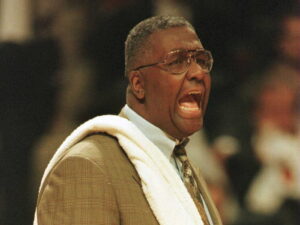by The Cowl Editor on October 29, 2020
Sports
by Leo Hainline ’22
Sports Staff
Legendary coach and former Friar John Thompson ’64 passed away in late August at the age of 78, leaving behind an unparalleled legacy.
Thompson was a pioneer in the game of basketball. He was the first African American to lead his team to an NCAA Tournament Championship, which he did in 1984 with Georgetown University. During his time coaching the Hoyas, Thompson completely altered the college basketball landscape. He helped the Big East become the most renowned basketball conference in the country. His passing is felt not just by Providence College and Georgetown University, but by the entire college basketball world. The passion Thompson brought in both helping his team succeed on the court and in helping his players succeed off the court is one of the greatest examples of embodying the Friar Family mantra.
Thompson grew up in Washington, D.C., where he was a standout basketball player for Archbishop Carroll High School. He would lead the team to three consecutive city championships. During his college career, Thompson was a star for the Friars, scoring 1,520 points and grabbing 1,061 rebounds in his four years. The big man led PC to the National Invitational Tournament title in 1963, and, as a senior, he was a First-Team All-American. He also helped bring the program to its first ever NCAA Tournament appearance. Thompson was drafted by the Boston Celtics, allowing him to play alongside the legendary Bill Russell. He won two NBA titles in his two-year NBA career.

Following his playing career, Thompson returned to D.C. to become the head coach of the men’s basketball team and a guidance counselor at St. Anthony’s High School. Georgetown noticed his local success and hired Thompson as their head coach in 1972. He inherited a team that went 3-23 before his arrival. In just a few short years, he would drastically improve the program, making the Hoyas regulars in the NCAA Tournament.
Thompson changed the culture at Georgetown, as he built the program around relentless defending. He made sure his players gave it their all—both on the court and in the classroom. Thompson once famously said, “I don’t coach their team. They play on my team.” This philosophy turned Georgetown into one of the most dominant programs in the country.
Georgetown reached new heights in the early ’80s when Thompson was able to land the most sought-after recruit in the sport, Patrick Ewing. With the 7-footer protecting the paint, the Hoyas became a perennial powerhouse while elevating the standing of the Big East. In Ewing’s first year as a Hoya, the program fell just short of winning the NCAA title. They lost by one point to a Michael Jordan-led University of North Carolina team in what many consider to be an all-time classic.
Two years later, Georgetown was crowned the NCAA champion after defeating the University of Houston in the finals. After the game, when asked about being the first Black coach to win the NCAA title, Thompson responded, “I’m not interested in being the first or only Black doing anything because it implies that in 1984, a Black man finally became intelligent enough to win the NCAA title, and that’s a very misleading thing.” Thompson believed that any Black person could have achieved what he did if they were just given the chance. He also asserted that the most important part of Georgetown’s win was bringing a championship to the Mid-Atlantic region, which had not had a team win the NCAA Tournament in 30 years.
Under Thompson, Georgetown became known as one of the most aggressive, physical, and toughest teams in the country. They took pressure defense to a whole new level and set the tone for the rest of the Big East, which soon became known as the most physical conference in college basketball. Some loved them, some hated them, but Thompson’s team was unquestionably built differently than any other team in college hoops. They were everyone’s rival: everyone wanted to beat Georgetown.
Thompson was at the head of a trend that saw Big East coaches become not just coaches, but also important figures in popular culture. Thompson was passionate and vocal while coaching, and standing at 6 feet 10 inches, his presence was always felt, regardless of whether spectators were in the arena or watching the game at home. He was one of the original, great coaches of the conference, along with the likes of Jim Boeheim at Syracuse University, Rollie Massimino at Villanova University, Lou Carnesecca at St. John’s University, and P.J. Carlesimo at Seton Hall University. These men all set the precedent of the Big East having some of the country’s best coaches and the most captivating personalities.
Each coach had his own distinct flair and style. Thompson was especially known for defending his players when they needed him. In an 1983 incident, Thompson removed his players from the court during a game against Villanova until racist banners targeting Patrick Ewing were taken down. Thompson also limited player interviews to protect them from the media, which often skewed stories or sometimes portrayed the almost all-Black Georgetown roster in an unfavorable light.
Along with his success on the court, Thompson’s care for his players and those around him off the court was also unique. He understood that life was about more than winning basketball games. He treated the people around him with kindness and respect. Indeed, John Thompson’s Georgetown teams transformed college basketball. His program boosted the reputation of the Big East, which had the effect of turning college basketball into must-see TV for average Americans in a way that it never was before.
Not everyone can replicate Thompson’s coaching brilliance on the sidelines, but everyone can look to him to see how we can make a positive impact on other people’s lives. The world truly lost one of the all-time greats with his passing.